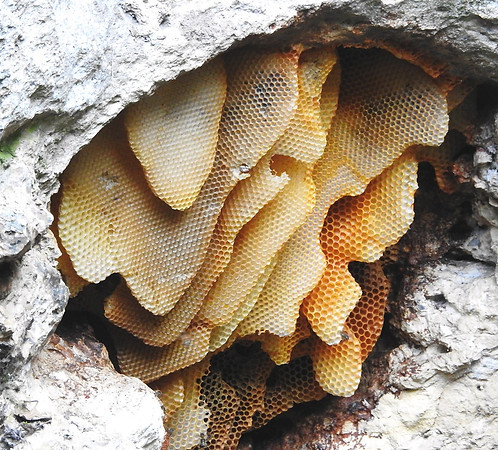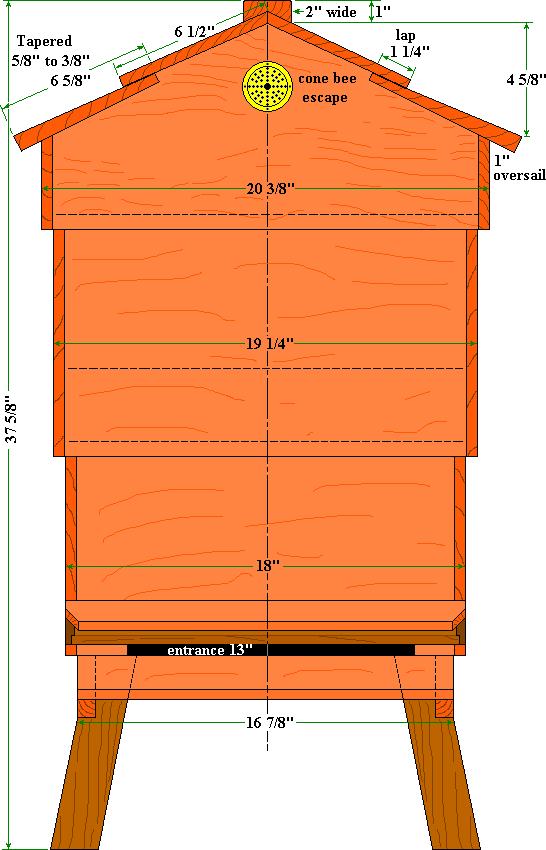
Roe Valley Beekeepers RVBKA
Based near Limavady, Northern Ireland
Email for Club: rvbkasecretarylhand@gmail.com
Email for Site: roevalleybeekepers@outlook.com



Bee Space
Close colony inspection by Rev LL Langstroth in 1851 revealed that bees reacted differently when confronted with spaces of different widths. If the space was less than 6mm, workers would attempt to seal the gap with propolis; if the space was more than 12mm, the workers would produce was comb within the space (brace comb). If the space was 8mm, the bees would work within the space.
Rev Langstroth experimented by building moveable frames of wood within hive boxes and determined that each frame would be separately removeable if the space between frames was 8mm. This discovery set the path to modern beekeeping techniques. Previously, bees were kept in Skeps or other hive types that had to be destroyed to extract a honey harvest.
With removeable frames, beekeepers could examine the progress of colony build-up, check for the presence of the queen, examine the health of adult bees and brood and determine amount and type of stores gathered.
Bee space is now used between frames, between the wall and the frames and between boxes.
Some hives use Top bee space and some use Bottom bee space. Top and Bottom space hive components must not be mixed up.






Basic Components and Description
All modern 'framed' hives contain the same basic parts:
Roof | Crown board | Super | Queen Excluder | Brood chamber | Floor | Entrance block
The Floor or hive base is a vital piece of the hive, most floors are made from a solid sheet of wood to help contain the internal temperatures and keep the frost out, more recently with the problems of Varroa an optional open wire mesh floor could be used to help remove the unwanted mite from the hive. In addition the mesh provides ventilation which some say it allows you to keep a narrow entrance fitted all year around which is easier for the bees to defend. A good size of mesh has holes of approx 4 mm large enough to allow the Varroa to fall through but small enough to keep the hive secure from unwanted pests.
Entrance Block is fitted to reduce access to the hive during the winter time to help keep the warmth in and unwanted visitors out, during the spring and summer it can be removed when the colony is of a suitable size to defend a larger opening and thus gives the flying bee's easier access directly into the hive. The entrance block should be refitted if the hive is being attacked by another colony or if the weather is poor for that time of season.
The Brood Box is the largest chamber of the hive, this is where the queen lives all year round and lays her eggs, the colony will also store pollen, nectar and honey for themselves in this chamber so its within easy reach. The maximum colony size is determined by the size of this chamber which is different depending on the type of hive. During the spring through to summer when the colony size has built up bee keepers will commonly split a colony, by removing some of the frames from the brood chamber which contain plenty of sealed brood, pollen and honey to start up a new colony in another hive nearby, then replace the frames. This is a good method to stop the colony from swarming.
The Queen Excluder is either a thin sheet of either steel or plastic with slots or holes cut in it. The holes are big enough to allow a female bee through but too small to allow the slightly larger queen or drone through. This then allows additional chambers or supers to be placed above which will only be filled with honey as the queen is kept from laying in this area.
The Super is the box of smaller frames for the bees to store excess honey, which the bee keeper will remove when its capped over and is ready to be extracted. When the weather has been favourable bee keepers will stack 2,3 or even 4 supers on top of the brood box and queen excluder. The supers are removed at the end of the season to reduce the total space of the hive to just the brood box to help the bees keep warm.
Crown Board is a flat sheet of wood with a hole in the centre and are used primarily as a cover on top of the brood chamber. The board creates a barrier to separate the different chambers of the hive and can be fitted with a bee escape or used to support a feeder.
The Roof some hives have either a plain felt or a metal sheet covered roof, they are a good weight to stop them being blown off in strong winds and help to trap the warmth in the brood box for winter time.
Comparison Table - Capacities and Size






Perspex Crown Board Benefits
A perspex crown-board, partically when built into an eke, is an easy and convenient way to have a view of the top bars without lifting the crown-board. Being able to quickly see how many frames the bees are moving on, whether they are in a cluster, how much fondant or supplement patty remains on the top bars, whether there is any condensation on the crown-board etc., without disturbing the colony is a bonus.
These observations can be made while topping up a rapid feeder or replacing fondant and supplement patties. A used matchstick under the crown-board corner stops condensation.




National Hive Bottom Bee Space
The most commonly used hive in Northern Ireland. Brood area 2,200 square inches. Use a double brood or deep brood box and frames for more space.
+ Long frame lugs for easy handling
+ Widely available and relatively inexpensive
- Smaller brood chamber may be quickly filled

BS Commercial Hive Bottom Bee Space
Most commonly used larger hive, favoured by large honey producers. Brood chamber is 3,000 square inches.
+ Larger brood area
- Full supers are heavy
- Short lug frames, more difficult for some to handle



Langstroth Hive Top Bee Space

Brood chamber of 2,740 square inches, with Supers of the same size. Most common hive outside the British Isles and parts of Europe.
+ Plenty of brood space (61,400 - 85,000 for Jumbo)
+ Simple to DIY build; dimensions are standard
+ Wide availability of resources, both equipment and publications
- Short lug frames, more difficult for some to handle
- Roof design is not deep enough for exposed sites


Click for Hive and frame construction by Ontario Bees
CDB Hive
+ Double-walled for insulation and weather-proofing
+ Lift can slide down to cover brood chamber in cold months
+ Good ventilation
+ Compact vertical design resists wind and is stable
+ Attractive
- Some parts are made from quite thin wood
- Heavier than some hives



Click for Escapes by dave-cushman.net
WBC Hive Bottom Bee Space


+ Double-walled: insulates for hot/cold weather
+ Outer wall consists of interleafing lifts
+ Attractive
+ Long lugs on frames
- Small brood chamber accommodates 45,000 bees
- Expensive and often stolen
- Cumbersome to move and fiddly to use
- Colony may be less aware of environmental conditions


Warre Hive
+ Vertical bars for bees to build their own comb
+ No foundation required
+ Less invasive than manipulating frames
+ Add empty boxes to the bottom, remove full boxes from top
+ Mimics how bees build comb in the wild
- Comb is more fragile
- Honey production is a little slower
- Adding boxes to the bottom may need 2 people


Flow Hive


There has been much criticism of the Flow Hive - that it encouraged lazy beekeepers who did not perform inspections, treat their bees for varroa or who take too much honey, too frequently. Lazy beekeepers with a profiteering mentality existed before the Flow Hive.
The hive is more expensive than most, but does make honey extraction more convenient. Prevent robbing by having the honey flow into a lidded bucket.

Top Bar Hive

+ No heavy lifting needed
+ Foundation-less beekeeping; no frames to assemble
+ Looks great
+ Best for pollination rather than honey production
- Cannot use a centrifugal honey extractor
+ The bees will have to make a new comb each year
+ Frequent inspections to check and prevent swarming


Other Hive Types


Smith - predominantly in Scotland, similar to a National, but with short frame lugs. Uses Top bee space and has capacity for 55,000 bees in the brood box.
Dadant - Large, popular in the USA
Dartington - A long, deep hive, often home-made
Rose - applied how wild bees thrive, to his desgin

Polystyrene Hives
+ Well insulated and damp resistant
+ No preservation treatment needed
+ To clean, soak in washing soda solution
+ Sterilise with household bleach: 1 part bleach to 6 parts water
+ Painting not required, but done for cosmetic reasons
+ Can be repaired with solvent free filler
+ Easy to assemble and light
- Can be chewed by bees
- May need more straps and top weight in windy conditions



Hive Stands


Main purpose is to raise hive entrance off the ground, discouraging pests and protecting from rot.
A stand makes inspections more comfortable and a wider stand can be a place to put upturned roof.
A better airflow to reduce internal condensation is also acheived.

Nuc Hives (nucleus)

A Nuc is a 5 frame brood chamber, with roof, crownboard and floor, typically used when buying/collecting bees from a local beekeeper. Comes with a new laying queen, up to 3 frames of eggs and brood and 2 of stores. Colony is transferred to a hive.
Uses of a Nuc:
-
Colony increase
-
Queen mating
-
Hiving a swarm
-
Transport queen cells between apiaries
-
Overwintering
-
Retirement home for a good aging queen
-
Re-queening - double screen method


